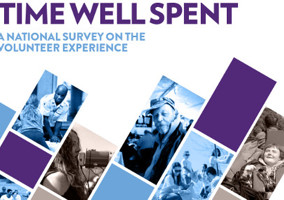It’s no surprise that the NCVO highlights in Time Well Spent so much for us to be proud of about volunteering in our country – from its scale to its contribution to civil society. Indeed, the popularity and ubiquity of the St John brand is entirely due to the demonstrative presence of our volunteers standing alongside so many of our communities, from fetes to football, homeless podiatry to Pride.
The fascinating insight of becoming a St John volunteer is that the readiness to act in a crisis is secondary to the deep desire to be a reassuring presence in the communities that the volunteers come from. It is this mindset that like so much volunteering knits our communities together. In our current worried socio-political state, this cohesion has seldom been more important.
And yet standing on the front line, I also know that volunteering can be challenging. The clear majority of our nation’s volunteers are happy with their experience, although interestingly Time Well Spent tells us that fewer people would recommend their volunteering to others. Is this because being a volunteer can be intolerably frustrating? All we want to do is give our time and skills and yet so many barriers are erected for us to hurdle.
As a charity leader as well as a volunteer I feel great responsibility to work hard on behalf of the volunteers to pull down those barriers. This is no time for complacency. For the great many people that haven’t considered volunteering, for whom it is a “nice idea, but I’ve got no time to spare”, we are letting them down if we don’t make every effort to support them to engage. To do this will require much greater pragmatism and much less bureaucracy and preciousness about the experience.
For me that’s not just about making volunteering easier, more accessible. It’s also about connecting or reconnecting to the communities in which volunteers live.
Some communities are just not feeling the benefit
Our voluntary sector has come a very long way in the last two hundred years since the Victorian philanthropic movement. We have developed our acumen as businesses, divested ourselves of many outdated processes and we are, in so many respects, more inclusive and more diverse than we have ever been.
However, if you root back into the histories of the oldest charities something else has changed. We are not as fundamentally rooted in our communities as we used to be. As a result, I worry that our volunteering is distant and inaccessible for many.
According to Time Well Spent, those from lower socio-economic groups were far more likely not to have even considered volunteering. This exclusion means they can’t benefit from the considerable positive mental health impacts and opportunities to learn new skills, build social relationships and improve cohesion in communities. What better ‘social prescription’ than volunteering?
So, how do we highlight these opportunities to the people and communities who could benefit from them the most?
Going back to the roots
As a new CEO, I have reflected deeply on the charity’s history to help me lead more effectively.
There is a fantastic image in our museum of a group of mineworkers in 1887. They are mineworkers with a mining rail cart in front of them and at their feet a stretcher is laid out. The cart has written across it ‘Tibshelf Colliery Centre – St Johns Ambulance Association’. It was these working communities who formed the local St John Ambulance Brigade.
The communities facing industrial accidents and work place fatalities were the starting point of the modern work of St John and it was for this socially just reason that Queen Victoria made the Order of St John a Chivalrous Order of the Crown in 1888.
Our heritage means that many of our modern units are already situated in working communities and our volunteers are drawn from all walks of life. Birmingham Central Cadet Unit is full to the brim with brilliant young people and many of them are drawn from areas facing deprivation. Remarkably it is still easy to see a 16 year old cadet working as a First Aider alongside a 60 year old volunteer as a First Aider with absolute parity, both from working communities and both driven to serve the community they are from.
It is this picture of accessibility and inclusion that is my benchmark. In essence my challenge is not to ‘bus in’ volunteers from suburbia but to empower local communities to be their own civil society.
Time Well Spent reports: “When volunteers were asked what they got out of their involvement, ‘I enjoy it’ was the most chosen statement.” This simple statement should not be underplayed, the simple triggers of satisfaction in volunteering whether that’s being the smiling face that directs someone to the nearest toilet or rushing to the scene of an accident under blue lights with adrenalin pumping are profoundly important to value.
Accepting these simple motivations as good enough reasons to explore volunteering, we should create opportunities for people do that more easily. Of course, there are many motivators and it’s no wonder we see so many of our young people desiring to enter training to be health care professionals, that too is a motivation worth valuing. Not the least of which because treated well and valued for their contribution they will, very often, continue with us as a volunteer paramedic, nurse and doctor into their sixties!
It’s time to be flexible
In the face of ever decreasing proportions of public resource being available to our most disadvantaged communities, we should, as the Scouts have done, target those areas as places from which we are most likely to recruit volunteers. Let us use this report to challenge ourselves, to redouble our efforts to make our volunteering experiences most accessible to the communities who need them the most.
In doing so we will serve the founding mission of our charities, echoed for us in the words of the St John motto: Pro Utilitate Hominum “For the Service of Humanity”.
|
Related articles












